Study Regarding the Education of Motor Expressivity and Musicality within the Gymnastic and Body Expression Activities
Abstract
Those who understand the multilateral value of physical education must admit the necessity to educate the expressive aspects of motricity as well. Expression exercises represent a strong motivation for the psychomotor development of children, facilitating expression, creativity and originality in choosing and performing motor actions with expressive qualities. Rhythmic, artistic, aerobic gymnastics, dance sport are sports activities that aim to educate the special body expressivity at a superior level characterized by a high degree of the communication function, through means having an artistic value. Assuming that gymnastic and body expression activities have an influence on the aesthetic side of pupils’ personality and leave their mark on children’s psychomotor education, our study was focused on the education and development of motor expressivity and musicality at various qualitative levels, from the spontaneous, natural manifestations to the mentally elaborated ones, expressed through meaningful body movement constructed with a well-determined purpose. During the experiment, our attention was oriented towards the motor gesture expression, the way of interpreting musical accompaniment, but also towards some personality traits able to facilitate the expressivity manifestation. We tried to stimulate the creative fantasy of subjects, who had to compose diverse motor structures, according to musical accompaniment. In the construction of trials, we had in view the display of transposition and expressivity availabilities; the combination of expression forms; a sufficient number of themes, stimuli and response situations. Without laying the stress on a particular body technique, we demonstrate within our experiment that certain artistic, aesthetic aspects can be educated.
Keywords: Gymnastic activities, body expression, motor musicality
Introduction
Specialty literature highlights a series of interesting aspects and data related toand
. Numerous authors (Allport, 1981; Pavelcu, 1969, 1982; Fraisse, 1970; Slama-
Cazacu, 1968; Neacşu, 1971; Ralea, 1957) were concerned with analysing and defining these terms.
Their valuable standpoints have oriented us towards understanding as a complex
phenomenon whose composition involves the intervention of inner elements, cognitive-affective
processes, attitudes, motivations, mental states, different personality traits.
Expression exercises may represent a strong motivation for the psychomotor development of
children, facilitating expression, creativity and originality in choosing and performing different motor
actions with expressive qualities. All possible forms of body expression have a remarkable educational
value, contributing to a better self-knowledge in the field of gesture.
Gymnastic and body expression activities reflect their influence on the aesthetic side of pupils’
personality and leave their mark on children’s psychomotor education. The educational perspectives
offered are unique and translate into the creation of emotions rich in meanings – motor expressivity.
If we approach expressive motricity within a systematic learning process, we can favourably
influence the pathway from the spontaneous-unconscious expression towards the educated expressive
behaviour, able to respond effectively to the communication and understanding needs, but also to the
social-cultural exigencies and norms.
In the process of educating expressive motricity, the subject must restructure and adapt his/her
movement, as a response to external temporal stimuli, “from this perspective, music playing a
particular role, because it is a temporal art which realizes the durations by organizing the sounds”
(Macovei & Vișan, 2003: 69). Musical accompaniment contributes to stimulating imagination, creating
some emotional states, educating motor communication capacity.
1.1. Purpose
Our study aims to prove, without focusing on a particular body technique, that some artistic-
musical-expressive aspects can be educated within the physical education and sports activities, using
certain means specific to expression activities. In our research, we focused attention not only on the
final assessment of the expressive-communicative value of motor gesture performed in accordance
with the particularities of musical accompaniment, but also on some personality traits contributing to
develop expression interiorly.
This research has started from the that the expressive and musical potential of each
subject can be valued within a learning process using a varied and original motor-artistic content
inspired from the dance field and some gymnastic activities which complement the classical training
means.
Materials and methods
Methods used: experimental method - ameliorative-ascertaining experiment, testing and assessment
method, statistical and graphical methods.
2.1. Subjects, organization and stages of the research (Table 1)
The experiment was conducted between January and June 2014, on a number of 6 girls in grades 4th
and 5th, members of the representative gymnastics and dance school team.

2.2. Trials and tests
During the experiment, our attention was oriented towards the motor gesture expression, the way of
interpreting musical accompaniment, but also towards some personality traits able to facilitate the
expressivity manifestation. We tried to stimulate the creative fantasy of the subjects, who were put in
the situation of composing themselves diverse motor structures, according to musical accompaniment.
In the construction of trials, we had in view the display of transposition and expressivity availabilities;
the combination of expression forms (directed, free, improvised ones); the use of a sufficient number of
themes, stimuli and response situations.
Without laying the stress on a particular body technique, we considered that certain artistic,
aesthetic aspects could also be pursued within the physical education classes, but insisting on the
educative, recreational and regenerating qualities of physical expression activities, with a beneficial
effect on pupil’s personality.
Motor trials were complemented with psychological tests: (1986)
(1974). The purpose was to identify the subjects’ introversion-extraversion level.
We did not proceed to establish the correlation (from the statistic point of view) between some
personality traits and the communication capacity through body expression; however, the collected
data allowed us, to a certain extent, to orient preparation.
2.3. Acting systems
Exercises for educating body and motor aesthetics (exercises specific to classical dance, executed
with support at wall bar and in the centre of gymnastic mat, thematic movement variants)
Exercises for educating rhythmicity and motor musicality (rhythmic themes with percussion and
musical games)
Exercises with hand apparatus
Exercises with body technical elements
Exercises for expression
These structures were applied over 6 months, 3 to 4 hours per week, the allotted time depending on
the school schedule.
The following scheme was pursued in planning the content of expression and rhythmic-musical
preparation (Table 2):

Ways of approaching the themes for expression:
Travels with walking and running variants Travels with a “significant value” Movements with a significance Travels: in pairs, in subgroups, all group Mimicking some actions – interpreting diverse roles using the body – that express moods, ideas Exercises with hand apparatus Exercises for educating body and motor aesthetics (exercises specific to classical dance) Exercises for improving motor memory, coordination and body technique Exercises for educating rhythmicity and motor musicality Exercises for space awareness, with an emphasis on zones, directions, levels, trajectories
2.4. Motor trials
The subjects were assessed by awarding them points from 1 to 10.
Trial 1 -: a 32-time structure which must present variety in the work plane and range of motion. Musical accompaniment in 4/4 time. Maximum number of
attempts: 3.
Trial 2 -: a rhythmic theme in 2/4 time, executed
through travels with rhythmic steps and turns, simultaneously with percussion, to mark the value of
musical notes. Maximum number of attempts: 6.
Trial 3 -: changing the pace of rhythmic steps in
accordance with the modification of tempos proposed for achieving the theme (moderate, slow and
fast tempos). Maximum number of attempts: 3.
Trial 4 - Capacity to perform expressive motor actions according to the character of music
: aimed at the subjects’ ability to adapt and transpose into the motor plane the
interpretative character of music, but also at their ability to select the most appropriate and
expressive means.
at the p-threshold of 0.05 and f = n - 1 = 5 in Fisher’s Table. We consider that the difference is
significant, with a probability of more than 95%.
Comparative presentation of the results (points) obtained at trial no. 1 by the experimental group
subjects is shown in Figure 1.
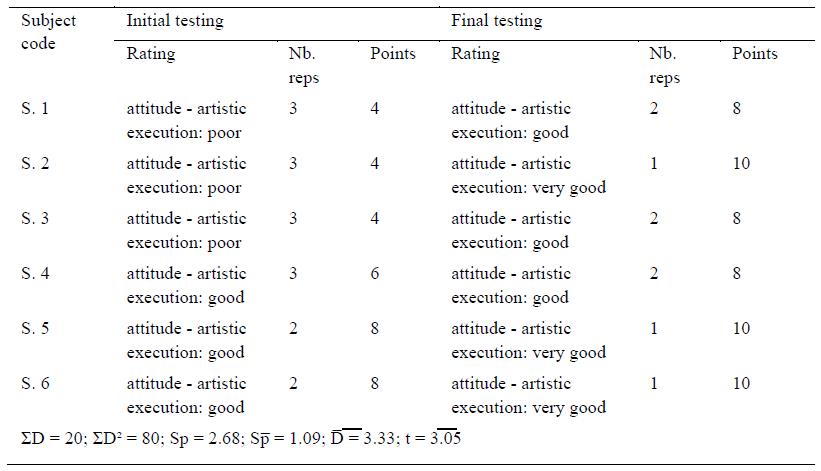
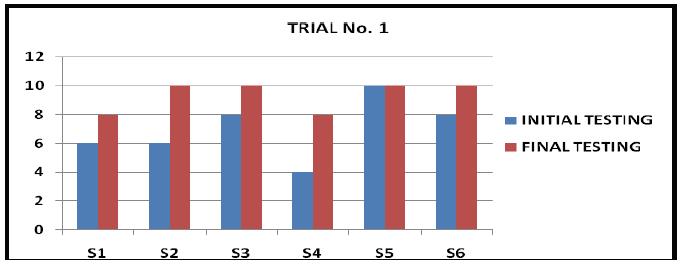
ΣD = 8; ΣD² = 18; Sp = 1.21; Sp̅ = 0.49; D̅ = 1.33; t = 2.71
At trial 2, the t-value is 2.71, which indicates that there is significant progress, with a probability of
more than 95%.
Comparative presentation of the results (points) obtained at trial no. 2 by the experimental group
subjects is shown in Figure 2.
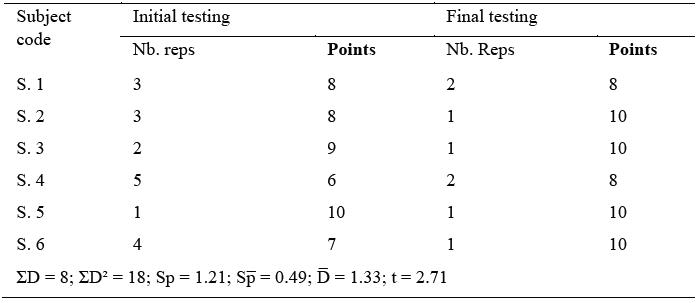
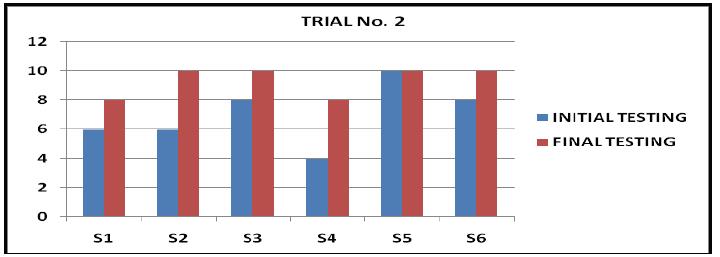
ΣD = 10; ΣD² = 40; Sp = 2.34; Sp̅ = 0.95; D̅ = 1.66; t = 1.74
Analysing the results presented in Table 5, we notice the subjects’ incapacity to execute the same
motor structure at different paces. This can be explained by the insufficient time allotted to rhythmic-
musical preparation within the experiment and by the age of the subjects. The recorded progress is not
significant, t = 1.74.
Comparative presentation of the results (points) obtained at trial no. 3 by the experimental group
subjects is shown in Figure 3.
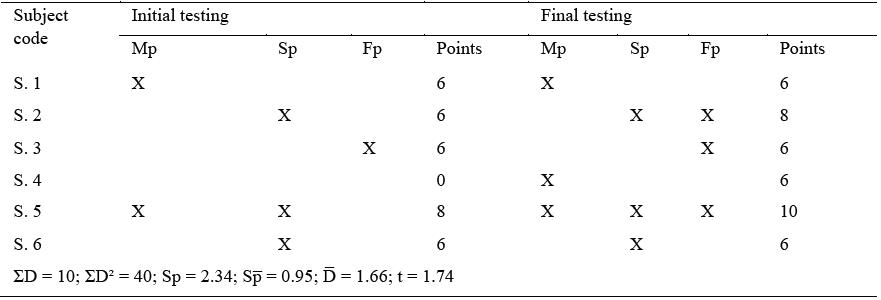
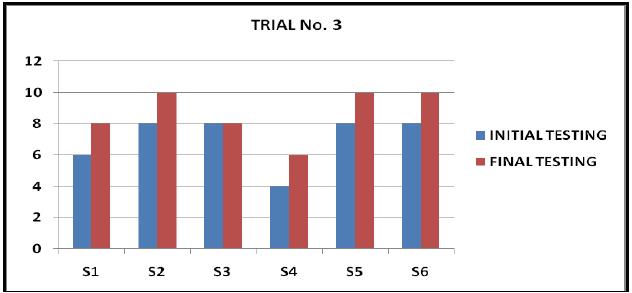
ΣD = 18; ΣD² = 60; Sp = 1.09; Sp̅ = 0.44; D̅ = 3; t = 6.81
Comparative presentation of the results (points) obtained at trial no. 4 by the experimental group
subjects is shown in Figure 4.
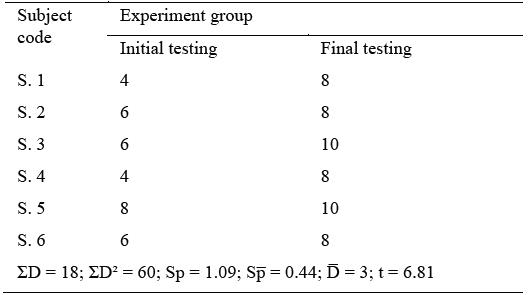
At trial no. 4, the subjects recorded significant progress, t = 6.81, with a probability of more than
99%. The quality of improvisation largely depended on the complexity of the theme and the technical
and artistic background of the subjects. Our subjects have imaginative, creative-productive potential.
After applying and interpreting the psychological tests: extraversion-neuroticism questionnaire -
Eysenck - form A (Table 7; Fig. 5) and Cattell’s anxiety scale (Table 8; Fig. 6), the following aspects
can be highlighted:
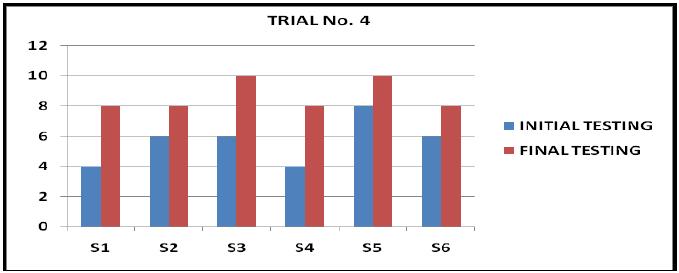
subjects are characterized by the ambivert personality type, with a tendency to
introversion; emotional stability (N< 6);subjects did not distort the responses
(L< 4-5 p).
The subjects are objective and effectively interpret the concrete situations, with a small dose of
subjectivity and imaginary interpretation of reality. In a 50% percentage, they consider themselves
responsible for the negative elements in their activity. The subjects show a slight state of nervousness
only in the presence of stressful elements (unknown persons), when they feel unprepared and when
they have to face a difficult task.
The subjects’ results are illustrated in Table 8 under the form of “raw scores”, in the third column,
and under the form of standard scores, for each test parameter, in columns Q3, C, L, O and Q4.

subjects frame within the “calm, relaxed” type, manifest a low anxiety level,
which denotes harmony, self-confidence, capacity of self-improvement, flexibility and good adaptation
to the specific activity carried out.
Conclusions after applying the psychological tests: the investigated subjects present easiness in
learning motor acts, have imaginative, creative-productive potential, good emotional stability and low
anxiety level (Fig. 5).

The subject S.M., although characterized by extraversion, achieved the best results in practical trials
and also proved prompt reactions, spontaneity and artistic expressivity in executing the proposed
themes.
The preparation for body expression approached within the experiment provides the introverts, too,
the opportunity to communicate through movement. Analysis of the results obtained in practical trials
confirms that most introverted subjects are expressive. It is difficult to correlate expression with a
certain personality trait, because expressive behaviour is the result of several determining factors.
Discussions and conclusions
The motor-artistic content applied during preparation was characterized by the variety of means and
the original approach, and was designed considering the subjects’ individual particularities. This has
stimulated communication through suggestive body expression and has contributed to the development
of motor expressivity.
The obtained results validate the research hypothesis and the efficiency of means used throughout
the proposed programme, conceived so that preparation includes aspects focused on expression,
rhythmicity and motor musicality.
It has been found that approaching a varied and original motor-artistic content contributes to
educating attitude and artistic execution, developing body expressivity, rhythmicity and motor
musicality, and stimulating communication through appropriate and suggestive body expression, as
well as the subjects’ artistic imagination.
Classical dance and rhythmic-musical preparation must be complemented with means mainly
focused on body expression. Programmes can be extremely diverse, providing thus for the children the
framework suitable to communication through movement rich in meanings.
All possible forms of body expression have a remarkable educational value, contributing to a better
self-knowledge in the field of gesture. Mastering one’s body will make children and young people
become aware of their own body; They will learn to create their own motor gestures and actions,
according to each one’s style and specific personality.
Expression exercises represent a strong motivation for the psychomotor development of children,
facilitating expression, creativity and originality in choosing and performing different motor actions
with expressive qualities.
Using a varied musical accompaniment contributes to educate the pupils’ sense of rhythm and form
their general music culture, which will make them able to understand the message of music and then
transpose it through expressive body movement.
References
Allport, G. (1981). Structura și dezvoltarea personalității. București: Editura Didactică și Pedagogică. Slama-Cazacu, T. (1968). Componente nonverbale în secvența mesajului. In Cercetări asupra comunicării, (pp. 155-164). București: Editura Academiei.
Cattell, R. B. (1974). Manuel d’application du test 16 PF. Paris: Centre de Psychologie Appliquée.
Eysenck, H. J., & Eysenck, S. B. (1986). Eysenck Personality Inventory - Form A. UK: Hodder and Stoughton.
Fraisse, P. (1970). Psihologie experimentală. București: Editura Științifică.
Macovei, S., & Vișan A. (2003). Acompaniamentul muzical. In Gimnastica aerobică de întreținere - Ghidul specialistului. București: Federația Română Sportul pentru Toți.
Neacşu, Gh. (1971). Transpunere şi expresivitate scenică. Bucureşti: Editura Academiei RSR.
Pavelcu, V. (1969). Din viața sentimentelor. Bucureşti: Editura Enciclopedică Română.
Pavelcu, V. (1982). Caracterele afectivității. In Cunoașterea de sine și cunoașterea personalității. Bucureşti: Editura Didactică și Pedagogică.
Ralea, M. (1957). Scrieri din trecut. Bucureşti: Editura de Stat pentru Literatură și Artă.
Smith, M. (1971). Ghid simplificat de statistică. București: Editura Științifică.
Copyright information

This work is licensed under a Creative Commons Attribution-NonCommercial-NoDerivatives 4.0 International License.
About this article
Publication Date
10 June 2016
Article Doi
eBook ISBN
978-1-80296-010-5
Publisher
Future Academy
Volume
11
Print ISBN (optional)
-
Edition Number
1st Edition
Pages
1-509
Subjects
Sports, sport science, physical education
Cite this article as:
Mihaela, M. (2016). Study Regarding the Education of Motor Expressivity and Musicality within the Gymnastic and Body Expression Activities. In V. Grigore, M. Stanescu, & M. Paunescu (Eds.), Physical Education, Sport and Kinetotherapy - ICPESK 2015, vol 11. European Proceedings of Social and Behavioural Sciences (pp. 96-105). Future Academy. https://doi.org/10.15405/epsbs.2016.06.14

